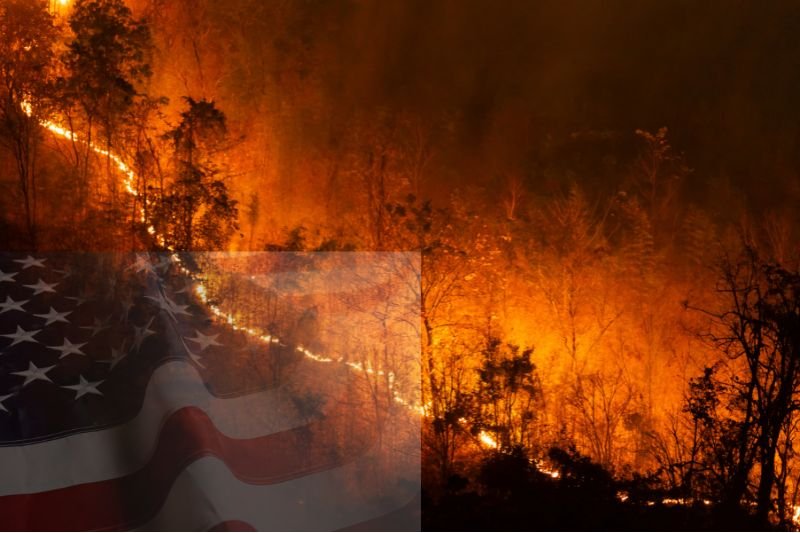A New Era of Climate-Driven Fire Disasters
Megafire survival is no longer a concern limited to rural areas or summer months—it’s becoming a year-round necessity across the American West. In recent years, the region has experienced a dramatic surge in large-scale wildfires. These are no longer seasonal threats but full-scale climate disasters.
Scientists now call them megafires—blazes that burn over 100,000 acres, fueled by rising temperatures, prolonged droughts, and extreme wind patterns.
What Are Megafires?
The term megafire describes wildfires of unprecedented intensity and scale. Unlike traditional wildfires, which may last hours or days, megafires can rage for weeks, consuming vast swaths of forest, entire towns, and everything in their path.
What makes these fires so dangerous is not just their size, but their unpredictability. Driven by extreme heat and wind, they create their own weather systems, including fire tornadoes and pyrocumulus clouds that can spread embers miles ahead of the main fire line.
Megafires are no longer rare. The United States sees an increasing number of them each year. In 2020 alone, California recorded five of the six largest fires in its history—all within a single season.
Why Are Megafires Becoming So Common?
The growing intensity and frequency of wildfires in the West are closely tied to climate change. Rising global temperatures have extended fire seasons, dried out vegetation, and created the perfect fuel conditions across vast regions.
Prolonged droughts, particularly in California and the Southwest, mean that forests and grasslands are tinderboxes. Add to that stronger winds, weakened snowpacks, and overgrown forests due to decades of fire suppression—and you have the ideal environment for uncontrollable fires.
Urban expansion into wilderness areas, known as the wildland-urban interface, further exacerbates the crisis. More people now live in high-risk zones, increasing both ignition sources and the potential for massive evacuations.
The Human Cost: Cities, Communities, and Health
The destruction caused by megafires is no longer confined to remote forests. Towns like Paradise, California were wiped off the map in minutes. Infrastructure such as power lines, water systems, and cell towers are routinely destroyed. Insurance markets are collapsing in fire-prone zones, and states are struggling to keep pace with disaster relief demands.
But beyond physical destruction, megafires have profound effects on public health. Smoke from wildfires can travel thousands of miles, impacting air quality across entire states. Exposure to fine particulate matter (PM2.5) can aggravate asthma, heart disease, and even trigger strokes.
Children, the elderly, and people with pre-existing conditions are especially vulnerable. In many areas, hospitals report increased emergency visits during fire season—not for burns, but for smoke inhalation-related complications.
Megafire Survival: Preparing for the New Normal
With wildfires now a permanent fixture of life in the West, megafire survival requires a combination of proactive planning, rapid response, and community cooperation.
Here are the core strategies every individual should consider.
Early Detection and Alerts
Modern fires can move faster than evacuation orders. It’s essential to have multiple alert systems in place.
Enroll in state and local emergency alert systems. Use NOAA weather radios with SAME alerts, and install wildfire tracking apps that use real-time satellite data.
Don’t rely solely on text messages or internet service, which may be down during an event. A battery-powered radio can be a lifesaver.
Have a Bug-Out Plan
In a megafire scenario, evacuation routes can be cut off within minutes. Every household in a fire-prone area should have a clear bug-out plan.
Map out at least two escape routes from your home, and pre-establish rendezvous points with family. Keep your vehicle gassed up and stocked with essential supplies.
Bug-out bags should include:
- N95 masks or better (for smoke protection)
- Fire blankets
- Water, non-perishable food
- Medications
- Paper maps
- Backup phone chargers
- Important documents
Pets, cash, and spare keys should also be part of your grab-and-go checklist.
Home Hardening and Defensible Space
Protecting your home against megafires begins long before fire season.
Create a defensible zone of at least 30 feet around your house by clearing dead vegetation, trimming trees, and spacing plants.
Use fire-resistant materials for roofing and siding. Install ember-resistant vents and cover gutters to prevent buildup of flammable debris.
Store firewood and fuel tanks away from the structure, and keep garden hoses with spray nozzles accessible. In high-risk areas, invest in rooftop sprinkler systems and fire gel coatings.
Air Quality and Indoor Protection
When evacuation is not possible, or during prolonged smoke exposure, protecting your indoor air becomes critical.
Seal windows and doors with weatherstripping. Use HEPA filters in air purifiers. Create a “clean room” in your home with filtered air where family members can safely stay during smoke surges.
Avoid vacuuming or burning candles during fire events, as they can further degrade air quality. Monitor local AQI levels and limit outdoor activity when levels rise above 150.
Long-Term Adaptation and Community Resilience
As megafires become more common, individual preparedness must be matched by community-level resilience.
Local governments should invest in fuel break systems, controlled burns, and resilient infrastructure. Schools and community centers should be equipped as clean-air shelters.
Survivalists and residents should form neighborhood networks for mutual aid. In rural areas, voluntary fire brigades and community training sessions can significantly increase response capacity.
Psychological Impact and Trauma
One of the lesser-known effects of megafires is their psychological toll. The fear of losing one’s home, the trauma of sudden evacuation, and the stress of rebuilding can lead to long-term anxiety, PTSD, and depression.
Preparing emotionally is just as important as stocking supplies. Build support systems with friends, neighbors, or online preparedness communities. Talk about fears with loved ones and develop mental resilience strategies.
Children, in particular, may need help understanding and processing disaster-related stress. Clear communication, routine, and creative expression can provide much-needed stability.
Are Megafires the New Normal?
The science is clear: megafires are no longer rare events—they are becoming the dominant pattern in the American West. Climate projections suggest longer fire seasons, more frequent droughts, and higher temperatures in the decades ahead.
Even with aggressive climate action, fire-prone ecosystems will take time to stabilize. In the meantime, megafire survival is no longer an option—it’s a necessity.
Those who prepare early, stay informed, and adapt to new realities will not only survive, but help lead their communities through the flames.















